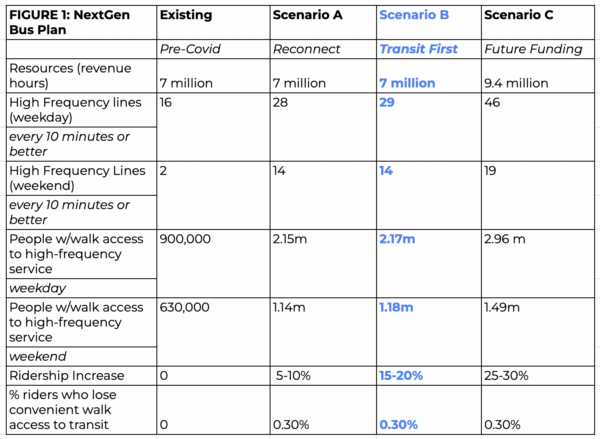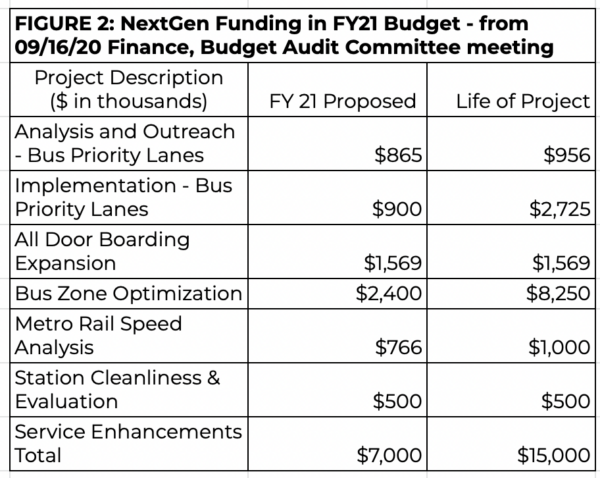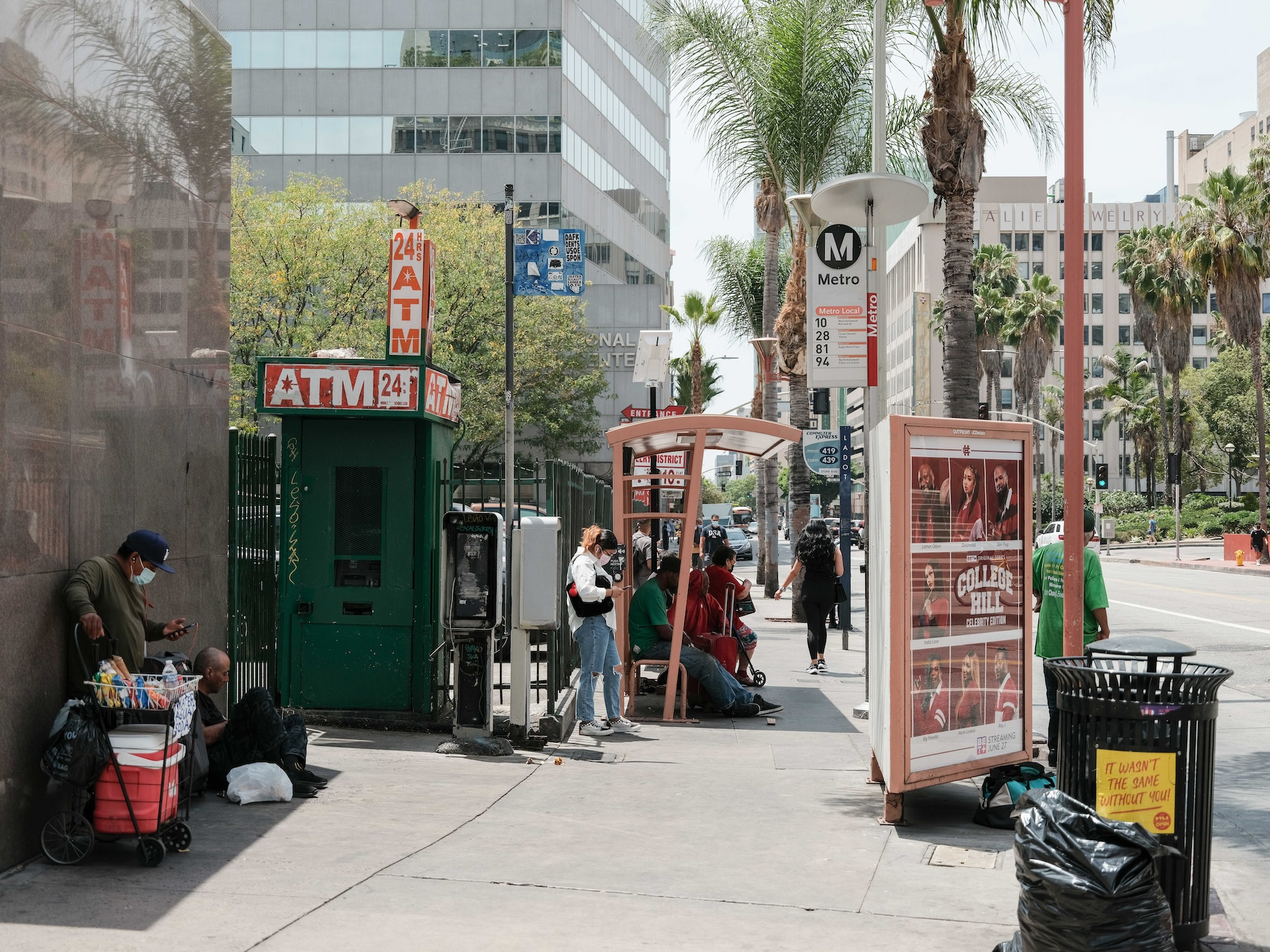When the Metro Board adopted the Transit First Scenario alternative for its implementation of the NextGen plan in January 2020 – just two months before COVID-19 lockdowns swept the U.S. – the plan’s aims were among the most ambitious that the agency had ever pursued. The Transit First alternative called for a significant reorganization of Metro’s bus service and major investments in busy corridors where riders have suffered long waits and slow rides for decades.
But Metro’s history is full of false starts. Many of the agency’s plans have been announced with public fanfare only to falter, ultimately resulting in no lasting changes for transit riders. And after two fraught years, it appears that the NextGen Transit First Scenario may be yet another such floundering plan.
But we do what we always do: we get to work to reveal the facts. We look for board motions, implementation reports, budgets and expenditures – the details of how plans can and have been implemented. While politicians may love a good press conference, we love a good balance sheet with the actuals. (In accounting, actuals are the recorded revenues and expenditures at a given point in time, as compared to the budget, which is only a forecast of income and spending projections.)
It has been challenging for the public and groups like ours to understand and engage in Metro’s budget prioritization for some time, particularly when it comes to the bus system because of the lack of detail on transit operations investments as well as the quick and one-way Metro budget public processes. Not to mention we never saw a detailed funding plan or project list for NextGen Scenario first. That was why we prioritized our work around these key issues last spring. And, through our Better Buses for LA work group, we created a comment letter that over 54 organizations and 276 individuals supported calling for several key issues such as:
- The allocation of resources to ensure greater procedural equity in FY23 budget-making.
- The expansion of bus service to meet existing needs and to prioritize bus capital improvements
And that’s why we were excited the Metro Board member Supervisor Mitchell responded to our concerns her amendment to motion 2021-0397 in May 2021:
- “Report back with a more thorough and participatory public and legislative process for future budgets and mid-year budget adjustments, including a board meeting that considers the budget exclusively.”
We now find ourselves in yet another year with a very similar budget outreach process which seemingly ignores Supervisor Mitchell’s request . This month there is a presentation about the process, and it does reference the new CEO listening sessions that happened in the fall of 2021. Investing in Place participated in one of the listening sessions. However, we have seen little change beyond that so far.
Without a more transparent budgeting and accounting process, the public isn’t able to help understand and shape the public dollars and infrastructure desperately needed by so many. At the bare minimum, Metro should be honestly sharing how much progress has made on implementing the NextGen Transit First Scenario (see Figure 1), which, according to the direction of the Metro Board, was scheduled to take place over 6 years and to include nearly $1 billion in capital spending and reallocated bus service hours to create an all-day, frequent, and reliable network.

The approach from Metro was: we shouldn’t add more buses until we fix the underlying infrastructure of the bus system. Metro identified that infrastructure, which includes things like bus stops, shelters, and the congested city streets in need of bus only lanes, as being the primary contributing factor to declining bus speeds. Consequently, fixing the underlying infrastructure meant consolidating bus stops, creating new bus-only lanes, allowing passengers to board through rear doors, implementing traffic signal priority for buses, and improving the bus stops themselves. The plan also included the elimination of almost all of the system’s Rapid buses, including the Santa Monica Boulevard Line 704, Venice Boulevard Line 733, West LA to Sylmar Line 734, with the idea being that their service would be consolidated back into local routes that would be making fewer stops.
While the rapid routes were actually eliminated, it’s unclear if speed improvements have actually been realized since data and implementation information has been hard to come by. What we do know is that by the end of June 2021, at least $7 million was allocated to be invested in bus speed improvements (see Figure 2).

Questions still linger…how much of that was spent and where? What was programmed for the following year in FY22? Is $7 million a year the best Metro can do given the critical importance the bus system is for so many people in the Los Angeles Region who are struggling to get by? These are the essential workers and others who rely on the bus for their daily needs during the pandemic. (Metro had the least amount of transit ridership loss during the past two years than any other transportation agency in the Country.) 
Since 2018, the Metro and LADOT bus speed work group has implemented 12.8 bus only lane miles, which is small but important progress on a very large problem.
To put it in perspective, remember the scale of the bus and street network in Los Angeles: the City of Los Angeles alone has 23,000 lane miles, and about 40% of those are major avenues and boulevards.
In addition to creating Bus Only Lanes (BOL), the Metro and LADOT work group is:
- Piloting red paint/thermoplastic treatment – In the summer of 2021 LADOT implemented this partial red thermoplastic treatment along portions of Wilshire Boulevard and the MyFigueroa segment in DTLA and has recently started applying it in and around downtown Los Angeles.
- Implementing their successful AB 917 State Legislation for Camera Bus Lane Enforcement. LADOT has recently started to develop implementation strategies for this legislation.
- Implementing Metro G Line (Orange) Busway signal improvements.
- And future work includes (per a Jan 2022 Board Report): “Metro continues to work with LADOT to improve editing Transit Signal Priority (TSP) and expand it to more buses and along non-TSP Tier 1 Corridors. Today on Metro Rapid Buses receive TSP, which can extend green lights to prioritize certain buses. Metro is exploring the viability to enable TSP on its entire 2,300 bus fleet.”
These are laudable projects. They also represent a welcome shift in the relationship between the City and Metro, which have often seemed to operate at cross purposes on the issue of bus service. But both the level of investment and the rate of progress are wholly incompatible with Los Angeles’s existing (let alone its forecasted) needs.
While COVID-19 has created trying and unprecedented conditions for many local government agencies, it has also presented tremendous opportunities to try new approaches. Federal COVID relief funds are ideal resources for the one-time fixes of many of the bus routes and services needed to improve operations and bus speeds. These investments would have a significant immediate and long lasting impact for the bus network.
But has any of that happened? With available public data we have been able to find so far, it’s just not clear.
Investing in Place has been attending NextGen Metro meetings since 2018. For years, we have written analysis, blog posts, comment letters, led convenings and work groups, collaborated with partners for organizing and advocacy with Metro Board members and at Board meetings, but now we find ourselves looking at data and conditions where Metro bus service is actually worse now than it was 25 years ago.
As we struggle to measure Metro’s adopted NextGen Plan, its stage of implementation, and the state of Metro’s bus service – we keep coming back to Metro’s opaque budget and funding prioritization process. We are seeking to understand why there seems to be no funding to substantially improve the Metro bus experience. It’s a publicly stated priority, yet the proof that investments have been made are less so.









You must be logged in to post a comment.